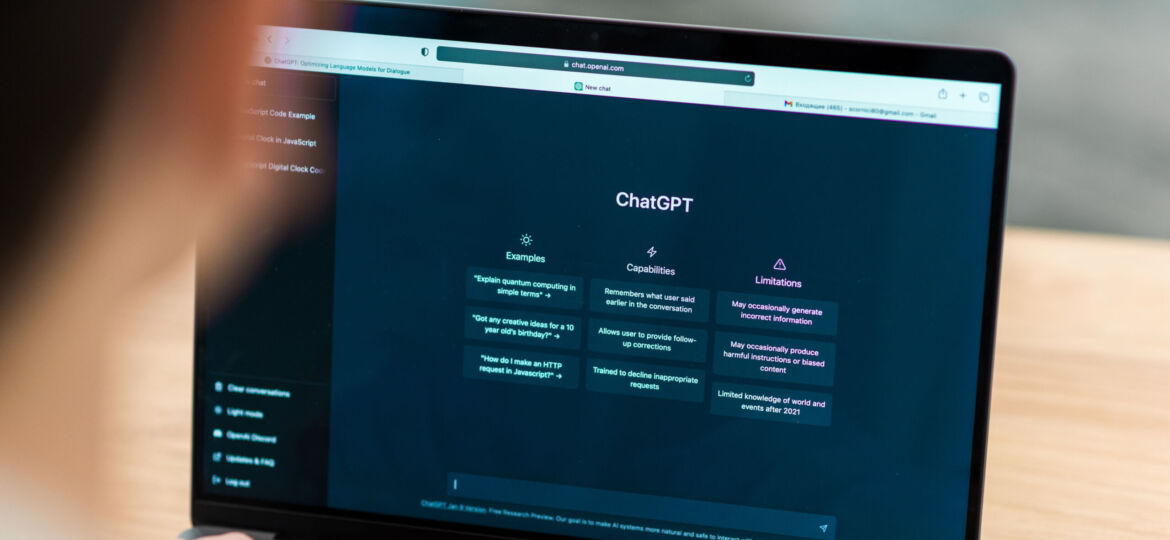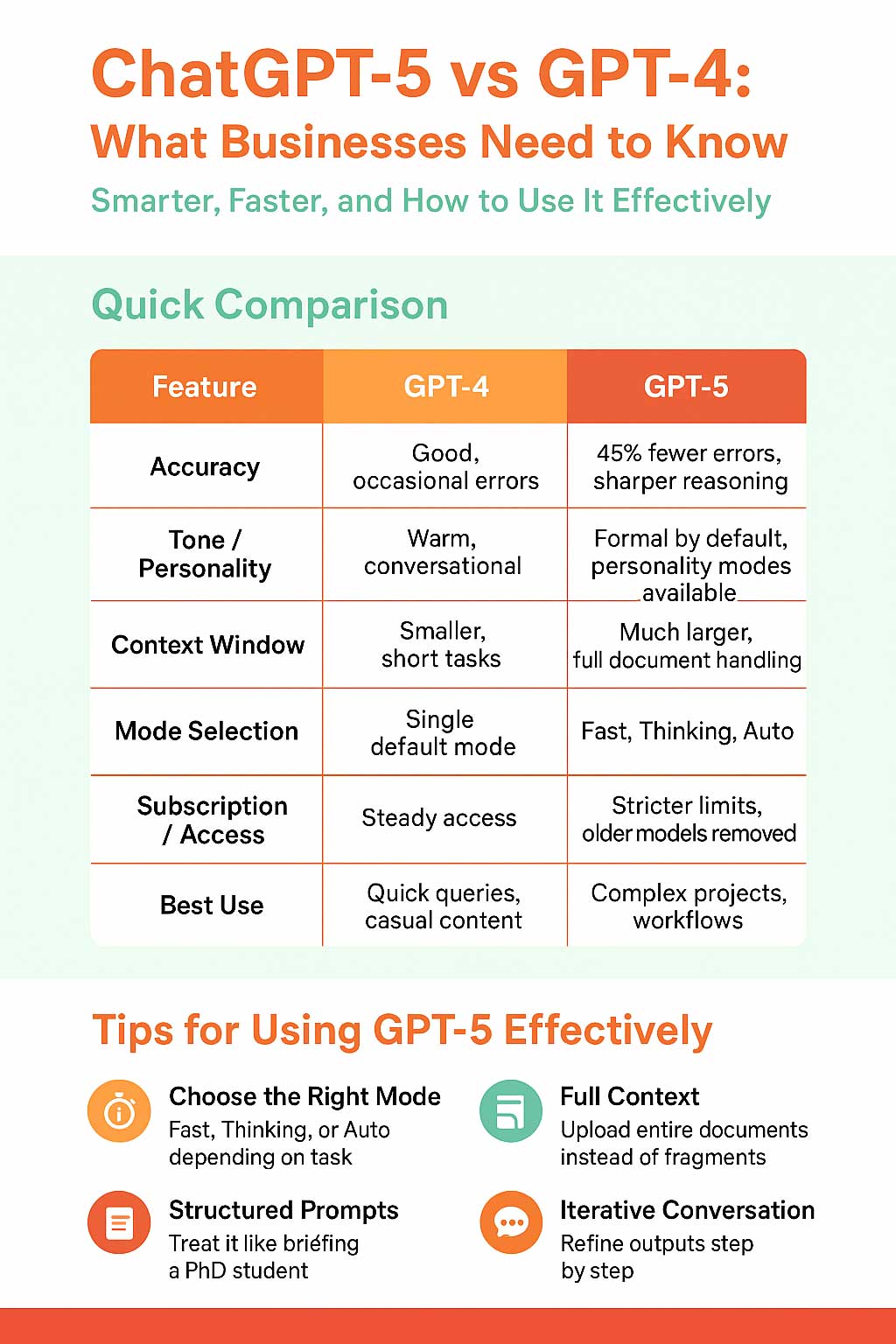
What Businesses Need to Know
Artificial intelligence is changing the way businesses operate, and ChatGPT has become one of the most talked-about tools for marketing, content creation, and workflow automation. With the launch of GPT-5 in August 2025, expectations were high. Smarter reasoning, faster responses, and more features promised a major leap forward. But users have had mixed reactions, and many are adjusting how they work with the new model.
ChatGPT-5 launched in August 2025 with a lot of noise. It promised smarter reasoning, better accuracy, and more features. But instead of celebration, the reaction online was mixed. Loyal users said it felt colder, less conversational, and in some ways harder to use.
So, what actually changed between GPT-4 and GPT-5? And how should businesses approach it? Here’s a closer look.
1. Yes, It’s Smarter
The numbers back it up: GPT-5 is more accurate and makes around 45% fewer factual errors than GPT-4o. It’s better at tackling complex reasoning tasks and can handle much bigger projects thanks to its extended memory.
For businesses, that means deeper research, sharper content, and a chance to streamline tasks that previously needed more human oversight.
One early adopter noted, “It’s remarkable how much more accurate it is, but the biggest thing I’ve noticed is speed.”
2. But It Feels Different
Here’s where the backlash comes in. GPT-4 was warm and conversational, often described as “a helpful friend.” GPT-5, on the other hand, comes across as more formal. Some users call it robotic, others say it feels like a corporate memo.
Another perspective: “5 is more accurate but less warm. Though, would we want to chat to ChatGPT as a friend? Maybe I prefer it colder.”
OpenAI has already responded by adding personality modes, so you can now choose whether you want a warmer or more enthusiastic tone. It’s a reminder that how AI sounds can matter just as much as what it says.
3. What Users Are Saying
Reactions to GPT-5 have been mixed. Many users appreciate the improved accuracy and speed, but some miss GPT-4’s warmth and conversational style.
From our team’s perspective, Daniel Ricardo added, “Smarter for sure, but it also feels more formal. I’m seeing sharper reasoning, yet less of the easy, conversational vibe many people loved. I’ve also noticed some odd slip-ups and tighter usage limits that make the everyday workflow a bit clunkier. My early take: it’s powerful, but you have to steer it differently.”
Across the board, users agree that GPT-5 is powerful, but it works best when guided carefully. Briefing it like a PhD student, selecting the appropriate mode for the task, and providing larger context all help get the best results.
4. Subscription Changes
Another source of frustration is how access has changed.
- GPT-4 gave Plus subscribers steady, unlimited access.
- GPT-5 launched with stricter limits, capping “good stuff” at 200 messages a week.
- Older models disappeared overnight, leaving paying users frustrated.
The perception? A downgrade disguised as an upgrade. Businesses relying on consistency from these tools suddenly had to rethink how they used them.
5. Bigger Context, Bigger Projects
One area where GPT-5 really shines is scale. The model’s context window is far larger than GPT-4’s. That means you can upload full documents and get meaningful analysis, instead of chopping projects into tiny chunks.
For businesses, this is a game-changer. Think research, reports, or entire content strategies processed in one go.
6. How to Get the Best from GPT-5
Despite the early bumps, GPT-5 can be extremely useful if approached correctly. Our recommendations:
- Experiment with personality settings to suit your brand voice
- Give structured, detailed prompts rather than one-liners
- Choose between Fast, Thinking, and Auto modes depending on the task
- Use it for larger projects where extended context shines
- Treat it as a conversation, refining outputs as you go
7. Why Businesses Should Care
For marketers and small businesses, the big takeaway is this: GPT-5 is not plug-and-play. It’s more powerful than GPT-4, but it requires a more thoughtful approach.
The improved accuracy and scale mean stronger research, sharper content, and faster workflows. But only if you invest the time in learning how to use it properly.
GPT-4 vs GPT-5: Quick Comparison for Businesses

| Feature | GPT-4 | GPT-5 |
| Accuracy | Good, occasional factual errors | 45% fewer factual errors, sharper reasoning |
| Tone / Personality | Warm, conversational, approachable | More formal by default, personality modes available (Listener, Nerd, Robot, Cynic) |
| Context Window / Project Size | Smaller, best for short tasks | Much larger, can handle full documents and complex projects |
| Mode Selection | Single default mode | Fast, Thinking, Auto – choose based on task complexity |
| Subscription / Access | Steady, Plus users had more consistent access | Stricter limits initially (200 messages/week), older models temporarily removed |
| User Guidance Needed | Less structured prompts needed | Best results with step-by-step instructions, clear expectations, iterative conversation |
| Best For | Quick queries, light research, casual content | Complex tasks, large content projects, business workflows, data-heavy tasks |
Final Thoughts
GPT-4 felt like a friendly assistant. GPT-5 feels more like a formal consultant. Both approaches have value, but they require different ways of working.
At Strategy Plus, we see GPT-5 as an opportunity. With sharper reasoning and the ability to process much larger projects, it has real potential for businesses that learn how to use it well. The key is adapting your approach, just as our team and other early adopters have, to get the most from what it offers.

